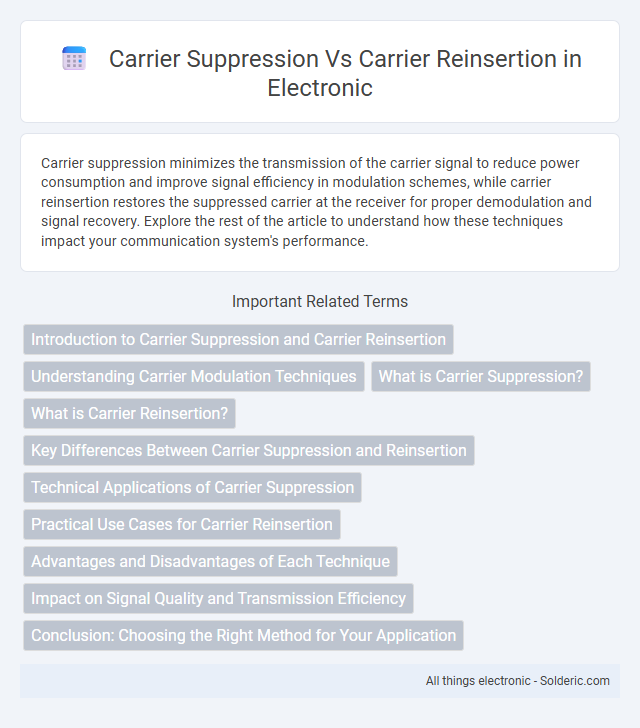Carrier suppression minimizes the transmission of the carrier signal to reduce power consumption and improve signal efficiency in modulation schemes, while carrier reinsertion restores the suppressed carrier at the receiver for proper demodulation and signal recovery. Explore the rest of the article to understand how these techniques impact your communication system's performance.
Comparison Table
| Aspect | Carrier Suppression | Carrier Reinsertion |
|---|---|---|
| Definition | Removing or minimizing the carrier wave in modulation to improve efficiency. | Reintroducing the carrier wave after transmission for demodulation purposes. |
| Purpose | Reduce power consumption and bandwidth usage. | Aid in signal recovery and synchronization at the receiver. |
| Modulation Types | Common in Double Sideband Suppressed Carrier (DSB-SC) and Single Sideband (SSB). | Used in standard Amplitude Modulation (AM) receivers and some coherent detection systems. |
| Power Efficiency | High, as carrier power is not transmitted. | Lower, carrier power is transmitted or reinserted. |
| Complexity | Higher transmitter and receiver complexity for carrier synchronization. | Simpler receiver design due to presence of carrier. |
| Signal Quality | Improved spectral efficiency; potential issues with phase synchronization. | Stable demodulation with consistent carrier reference. |
Introduction to Carrier Suppression and Carrier Reinsertion
Carrier suppression eliminates the transmission of the carrier wave to reduce power consumption and minimize interference, making modulation schemes like double-sideband suppressed carrier (DSB-SC) more efficient. Carrier reinsertion involves reintroducing the carrier at the receiver or transmitter to enable coherent demodulation, improving signal recovery and overall communication quality. Understanding the balance between carrier suppression and reinsertion is crucial for optimizing your modulation system's performance and bandwidth efficiency.
Understanding Carrier Modulation Techniques
Carrier suppression reduces the amplitude of the carrier signal in modulation to enhance bandwidth efficiency and minimize power consumption, commonly used in double sideband suppressed carrier (DSB-SC) systems. Carrier reinsertion involves restoring the carrier at the receiver or transmitter to facilitate demodulation, ensuring signal integrity and ease of recovery in amplitude modulation (AM) schemes. Understanding the balance between these techniques helps you optimize communication system performance by managing trade-offs in power usage and signal clarity.
What is Carrier Suppression?
Carrier suppression is a modulation technique where the carrier signal's amplitude is significantly reduced or entirely removed during transmission to enhance power efficiency and reduce interference. This method is commonly used in suppressed-carrier amplitude modulation and double-sideband suppressed-carrier (DSB-SC) systems, optimizing signal strength and bandwidth usage. Understanding carrier suppression helps you improve communication system performance by minimizing unnecessary carrier power.
What is Carrier Reinsertion?
Carrier reinsertion is a technique used in communication systems to restore the carrier signal after carrier suppression modulation, ensuring proper demodulation and signal synchronization at the receiver. It involves reintroducing a reference carrier frequency to facilitate coherent detection, improving signal integrity and reducing distortion. This process is critical in applications like amplitude modulation (AM) and quadrature amplitude modulation (QAM), where the absence of a carrier complicates accurate data retrieval.
Key Differences Between Carrier Suppression and Reinsertion
Carrier suppression eliminates the original carrier signal to reduce power consumption and increase signal efficiency, primarily used in single sideband (SSB) modulation. Carrier reinsertion involves adding back the suppressed carrier at the receiver to enable proper demodulation and accurate signal recovery. Understanding these key differences helps optimize your communication system's balance between spectral efficiency and signal clarity.
Technical Applications of Carrier Suppression
Carrier suppression is widely used in technical applications like single-sideband (SSB) modulation to improve bandwidth efficiency and reduce power consumption by eliminating the carrier frequency from the transmitted signal. This technique enhances signal-to-noise ratio and minimizes interference in communication systems, making it ideal for long-distance and high-frequency transmissions. Your communication equipment benefits from carrier suppression by providing clearer signals and more efficient use of spectrum, whereas carrier reinsertion is necessary for demodulation and signal recovery at the receiver end.
Practical Use Cases for Carrier Reinsertion
Carrier reinsertion is essential in communication systems where signal integrity must be maintained, such as in digital subscriber lines (DSL) to enhance data transmission reliability. You find carrier reinsertion practical for minimizing signal distortion and improving synchronization in multiplexing techniques like single-sideband (SSB) modulation. This approach ensures efficient bandwidth utilization and reduces interference compared to carrier suppression methods.
Advantages and Disadvantages of Each Technique
Carrier suppression reduces bandwidth usage and enhances power efficiency by eliminating the carrier signal, making it ideal for long-distance communications but complicating receiver design due to the need for precise carrier recovery. Carrier reinsertion simplifies demodulation and improves signal robustness against noise by reintroducing the carrier at the receiver, though it increases bandwidth consumption and power requirements. The choice depends on trade-offs between system complexity, spectral efficiency, and noise resilience in communication applications.
Impact on Signal Quality and Transmission Efficiency
Carrier suppression reduces the carrier power in modulated signals, enhancing transmission efficiency by lowering unnecessary energy consumption and minimizing interference, which improves overall bandwidth utilization. Carrier reinsertion restores the carrier at the receiver or transmitter, ensuring better signal quality with easier demodulation and synchronization, but increases power requirements and potential spectral congestion. Balancing carrier suppression and reinsertion is critical for optimizing both signal integrity and efficient use of transmission resources in communication systems.
Conclusion: Choosing the Right Method for Your Application
Carrier suppression reduces signal power near the carrier frequency, enhancing spectral efficiency and minimizing interference in high-data-rate applications. Carrier reinsertion improves demodulation robustness by restoring the carrier, making it suitable for systems requiring stable phase reference and lower bit error rates. Selecting the right method depends on application needs: prioritize carrier suppression for bandwidth efficiency and carrier reinsertion for signal reliability and simpler receiver design.
carrier suppression vs carrier reinsertion Infographic

 solderic.com
solderic.com